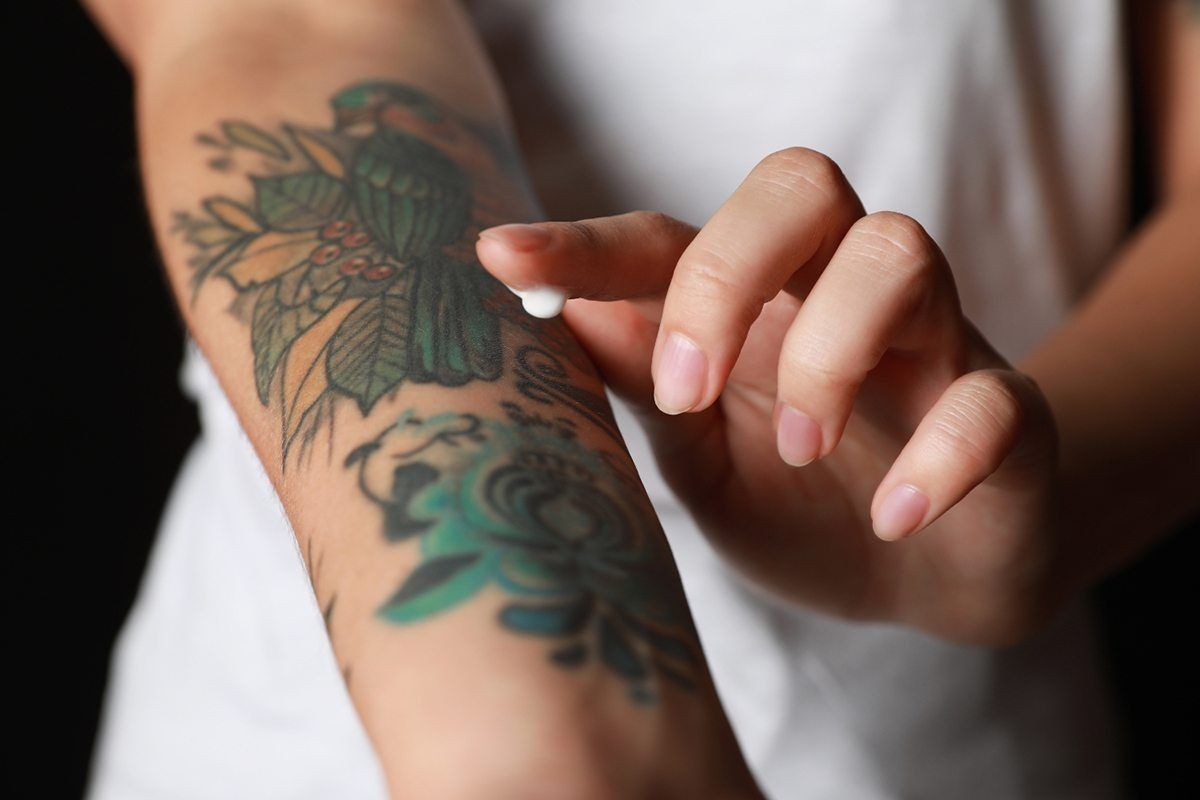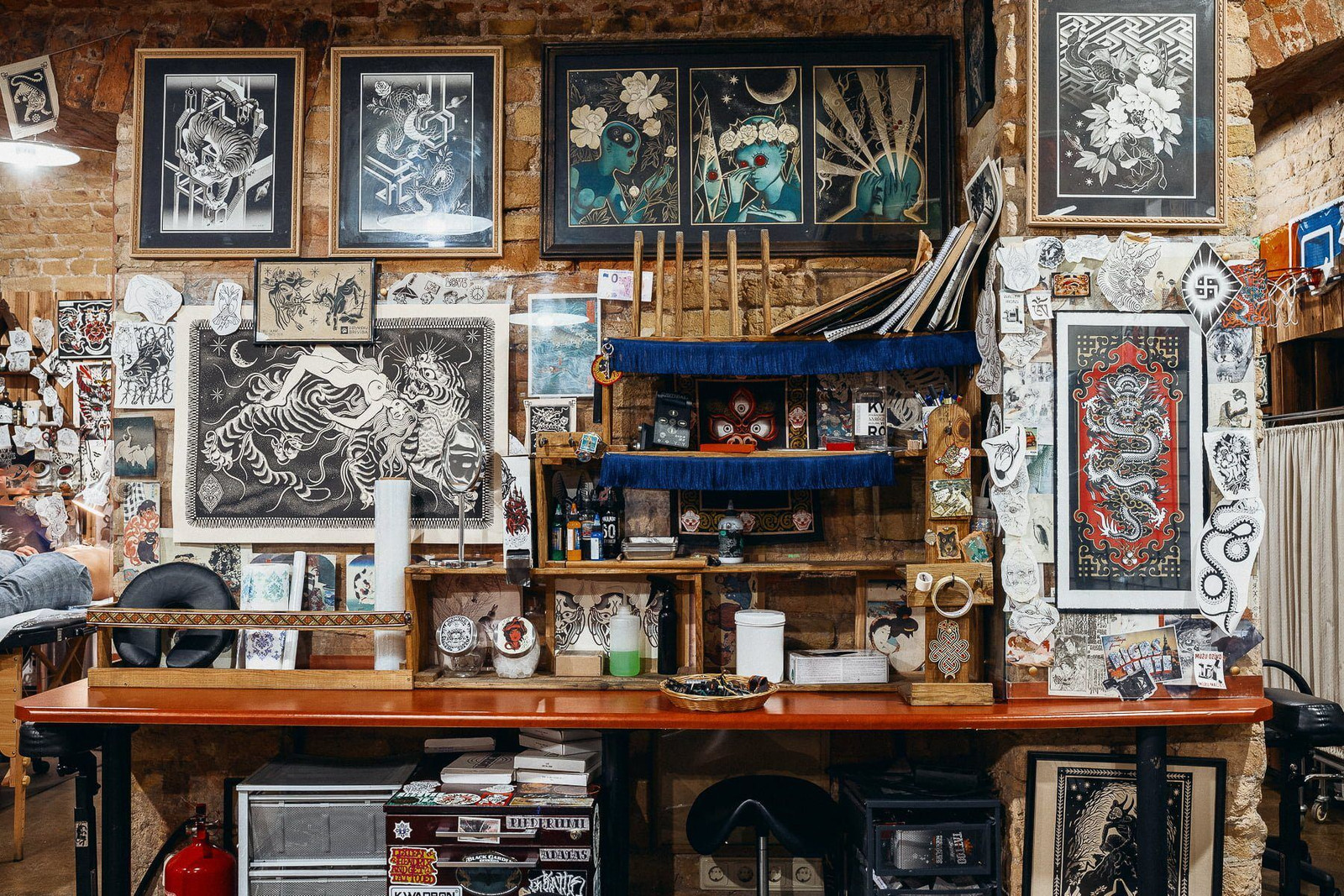A complete guide to tattoo care with Rīgas Tinte
Proper tattoo care is very important for the appearance and longevity of your tattoo, as well as for the overall health of your skin. This guide is a compilation of knowledge designed to provide you with the most accurate and effective tattoo care methods.
The First 48 Hours
Immediate Care
The first 48 hours are very important to determine how well the tattoo will heal. Once the tattoo artist has completed the tattoo, your skin begins the natural healing process. A bandage will be applied to protect the fresh tattoo and prevent infection. Keep this bandage on for at least a few hours, but no longer than 12 hours. The aim is to keep the area clean and protect it from bacteria.
Bandages
There are different types of bandages used in the tattoo industry, each with its own pros and cons. The traditional method involves the use of a film, which is effective but may require frequent changes. Some studios prefer to use ‘second skin’ products such as Tattoomed or Dermalize. These are adhesive films that provide a breathable barrier, protecting the tattoo while allowing the skin to heal. The tattoo artist will give you instructions on what best suits their tattooing method and your skin type.
Washing the Tattoo
After removing the bandage, it’s time for the first wash. Use lukewarm water and a mild, fragrance-free soap. Gently wash off the tattoo ink and blood, then dry the area with a clean towel. Avoid using hot water as this can open the pores and possibly cause the ink to fade. Also avoid rubbing the tattoo; your touch should be as light as a feather.
Remember that the first 48 hours are very important. Your tattoo is essentially an open wound and needs to be treated very carefully to prevent any infection and to ensure that it heals well.
Week 1: Probably the most important stage
Daily Cleaning
The first week is a very important period for a tattoo. The daily washing routine should be consistent but not excessive. Excessive cleansing can strip the skin of its natural oils, which are essential for healing. Two times a day – once in the morning and once before going to bed – is sufficient. Use lukewarm water and a mild, fragrance-free soap. Do not scrub, but dry your skin with a clean towel.
Moisturizing
After washing, it is time to moisturize the tattoo area. The right ointment or lotion can make a big difference to the healing of the tattoo. Avoid petroleum-based products as they can clog pores and affect the color of the tattoo. Choose a specialized tattoo after-care product or a hypoallergenic, fragrance-free lotion. Apply thinly; the skin must be able to breathe. Excessive moisturizing can cause the skin to dry out.
Signs of Infection
Although it is normal for a tattoo to be slightly red and swollen in the first few days, any excessive redness, heat or pus may be a sign of infection. If you notice severe itching, a rash or if the touch is unusually warm, contact the studio or seek medical attention immediately.
Week 2: The Healing Phase
Scabbing
In the second week, you will notice that the tattoo is starting to peel. This is a natural part of the healing process. Do not tear off the crepe, otherwise you may end up with some of the tattoo ink coming out. Let the welt fall off naturally. If a piece of the scab accidentally comes off (it happens!), clean the area and apply a thin layer of antibiotic ointment.
Itching
Ah, itching – a sure sign that a tattoo is healing, but also incredibly annoying. Resist the urge to scratch your tattoo. Scratching can cause the ink to fade and can cause scarring. Instead, tap the area gently or apply a cold compress. Some people find relief by gently applying a hypoallergenic lotion.
Physical Activity
Although you can resume most of your usual sporting activities immediately after getting a tattoo, there are some that should be avoided to ensure better healing of the tattoo. For example, contact sports such as wrestling, hockey, etc. Any activity that causes excessive sweating can cause bacteria to multiply in the wound. To prevent exposure to bacteria be sure to avoid swimming in pools or open water, soaking in the bath, jacuzzi until the tattoo is completely healed. For the first 14 days, use only the shower for bathing.
By following these guidelines, you will ensure that you have a beautifully healed tattoo that will look good in the long run. Remember that every tattoo is unique, just like everyone’s skin. Always consult your tattoo artist for individual advice!
Week 3: Stabilization Phase
As weeks 3 and 4 begin, you will notice that the colors may fade slightly; this is completely normal. Your skin is still healing and the top layer of skin may make the tattoo less vivid. Don’t worry, as your skin continues to rejuvenate, the colors will recover, appearing brighter than before.
Exposure to the sun
By now the tattoo has healed well, but it is still sensitive, especially to sunlight. UV rays can cause the tattoo to fade prematurely. If you plan to be outdoors, make sure your tattoo is covered by clothing or use a high SPF sunscreen specifically designed for tattoos. Remember that sun protection is not just a requirement of the healing phase, but a long-term commitment to keep your tattoo looking its best.
Resuming Activities
You can resume normal activities such as swimming and going to the gym, but with caution. Make sure the pool you swim in is well chlorinated and avoid soaking your tattoo for long periods of time. At the gym, wipe down any equipment that may come into contact with the tattoo to avoid bacterial infection.
Long-Term Care
Moisturizer
Even after the tattoo has completely healed, moisturizing is still an essential part of tattoo care. A well moisturized tattoo will look brighter and more vibrant. Choose a hypoallergenic, fragrance-free lotion or a specialized tattoo moisturizer.
Sun Protection
We can’t stress this enough: sun protection is vital for the longevity of your tattoo. Always apply a sunscreen with a high SPF before going out in the sun. This will not only prevent the tattoo from fading, but also protect your skin from possible sun damage.
Tattoo correction
Even the best tattoos may need correction after a few years. Fading is natural over time and lifestyle factors such as sun exposure can speed up the process. If you notice that your tattoo needs a touch up, talk to your tattoo artist about correction options. It is usually best to wait at least a few months after your first tattoo session to consider having your tattoo touched up.
Always remember that a tattoo lasts a lifetime, so make sure you take proper care of it!
Common Myths and FAQs
Dry Healing vs. Moisturizing
One of the most debated topics in tattoo aftercare is whether to let the tattoo dry heal or to keep it moisturized. Dry healing advocates believe that leaving the tattoo alone speeds up the natural healing process. However, this method can lead to excessive scabbing and may cause the tattoo to lose color and clarity. On the other hand, moisturizing helps in keeping the skin supple, reducing scabbing and aiding in color retention. The consensus among most experts is that a balanced approach—keeping the tattoo slightly moisturized but not overly so—is the best route for optimal healing.
Tattoo Brightening Lotions
You might have come across lotions claiming to “brighten” your tattoo. While a good moisturizer can make a tattoo look more vibrant, be cautious of products that promise miraculous results. Often, these lotions contain ingredients that may irritate the skin. Always consult your tattoo artist or dermatologist for product recommendations.
Exercise and Tattoos
A common myth is that sweating will cause the ink to run or fade. While it’s true that excessive moisture isn’t good for a healing tattoo, normal amounts of sweat during exercise shouldn’t affect your tattoo. However, it’s advisable to avoid exercises that will stretch or excessively rub the tattooed area for the first couple of weeks.
Conclusion
Tattoo aftercare is not just a phase; it’s a long-term commitment to maintaining the beauty and integrity of your ink. This guide, grounded in expert advice and scientific research, is designed to navigate you through the healing journey of your tattoo. By following these guidelines, you’re ensuring that your tattoo remains as vibrant and meaningful as the day you got it.



